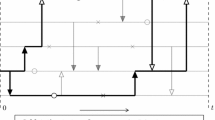Abstract
We consider the genome of a sample of n individuals taken at the end of a selective sweep, which is the fixation of an advantageous allele in the population. When the selective advantage is high, the genealogy at a locus under selective sweep can be approximated by a comb with n teeth. However, because of recombinations during the selective sweep, the hitchhiking effect decreases as the distance from the selected site increases, so that far from this locus, the tree can be approximated by a Kingman coalescent tree, as in the neutral case. We first give the distribution of the tree at a given locus. Then we focus on the evolution of this tree along the genome. Since this tree-valued process is not Markovian, we study the evolution of the Ancestral Recombination Graph along the genome in case of selective sweep.
Similar content being viewed by others
References
Durrett R (2008) Probability models for DNA sequence evolution, 2nd edn. Springer, Berlin
Etheridge A, Pfaffelhuber P, Wakolbinger A (2006) An approximate sampling formula under genetic hitchhiking. Ann Appl Prob 16: 685–729
Griffiths RC (1981) Neutral two-locus multiple allele models with recombination. Theor Popul Biol 19: 169–186
Griffiths RC and Marjoram P (1997) An ancestral recombination graph. In: Donnelly P, Tavaré S (eds) Progress in populationgenetics and human evolution. IMA volumes in mathematics and its applications. Springer, New York, pp 257–270
Hudson RR (1983) Properties of the neutral model with intragenic recombination. Theor Pop Biol 23(2): 183–201
Leocard S (2009) Selective sweep and the size of the hitchhiking set. Adv Appl Probab 41: 731–764
Maynard-Smith J, Haigh J (1974) The hitch-hiking effect of a favorable gene. Gen Res 23: 23–35
McVean G (2007) The structure of linkage disequilibrium around a selective sweep. Genetics 175: 1395–1406
Nielsen R, Williamson S, Kim Y, Hubisz MJ, Clark AG, Bustamante C (2005) Genomic scans for selective sweeps using SNP data. Gen Res 15(11): 1566–1575
Pfaffelhuber P, Studeny A (2007) Approximating genealogies for partially linked neutral loci under selective sweep. J Math Biol 55: 299–330
Schweinsberg J, Durrett R (2005) Random partitions approximating the coalescence of lineages during a selective sweep. Ann Appl Probab 15: 1591–1651
Stephan W, Song YS, Langley CH (2006) The hitchhiking effect on linkage disequilibrium between linked loci. Genetics 172: 2647–2663
van Herwaarden O, van der Wal N (2002) Extinction time and age of an allele in a large finite population. Theor Pop Biol 61: 311–318
Wiuf C, Hein J (1999) Recombination as a point process along sequences. Theor Popul Biol 55: 248–259
Author information
Authors and Affiliations
Corresponding author
Additional information
This work was supported in part by ANR MAEV under contract ANR-06-BLAN-0113.
Rights and permissions
About this article
Cite this article
Leocard, S., Pardoux, E. Evolution of the ancestral recombination graph along the genome in case of selective sweep. J. Math. Biol. 61, 819–841 (2010). https://doi.org/10.1007/s00285-009-0321-4
Received:
Revised:
Published:
Issue Date:
DOI: https://doi.org/10.1007/s00285-009-0321-4




